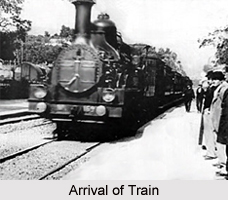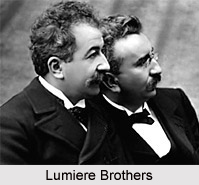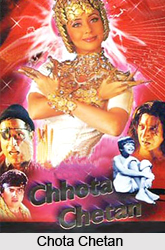 The prehistoric era in Indian cinema started with the coming of the Lumiere Brothers` films. After demonstrating their cinematography to Europe the Lumiere brothers took their art to Asia through representatives. In India it was to Mumbai, the erstwhile Bombay, which had the honor of receiving the first envoys of this new invention. The main reason for opting Bombay was that it had an English speaking Indian elite population as well as many British inhabitants. It was finally on 7th July, 1896, at Hotel Watson in Bombay. The Lumiere operator Maurice Sestier presented the first reels ever shot of real films. The show consisted of films, such as, Arrivée d`un Train á la Gare de la Ciotat (The Arrival of a Train at the Ciotat Station) and La Sortie de l`Usine (Leaving the Factory). The audience comprised of English and Westernized Indians.
The prehistoric era in Indian cinema started with the coming of the Lumiere Brothers` films. After demonstrating their cinematography to Europe the Lumiere brothers took their art to Asia through representatives. In India it was to Mumbai, the erstwhile Bombay, which had the honor of receiving the first envoys of this new invention. The main reason for opting Bombay was that it had an English speaking Indian elite population as well as many British inhabitants. It was finally on 7th July, 1896, at Hotel Watson in Bombay. The Lumiere operator Maurice Sestier presented the first reels ever shot of real films. The show consisted of films, such as, Arrivée d`un Train á la Gare de la Ciotat (The Arrival of a Train at the Ciotat Station) and La Sortie de l`Usine (Leaving the Factory). The audience comprised of English and Westernized Indians.
A week later the Novelty Theatre started projections of the vast stock of short films of the Lumiere repertory. These films were accompanied by an orchestra and attracted house-full shows. Men and women were seated separately in the audience and tickets were affordable too. In no time at all the hugely popular travelling shows were including these short films in their programmes. After these followed films like James B. Stewart`s Vitagraph in 1897 and Moto-Photoscope by Ted Hughes and others. The projections often took place in prestigious theatres but were also held under tent like canopies or on grounds, popularly known as `maidans.` The other two metropolises of colonial India-Kolkata and Chennai soon followed suit. Kolkata was then the capital of British Raj and it had its first cinema hall was set up in 1898. On the other hand Chennai had its first movie theatre in 1900.
The projections of short newsreels started in 1897-98. These were films with titles, such as, The Races in Poona or A Train Entering the Station in Mumbai. These films were generally shot by European cameramen. Other subjects included the bazaars, religious processions, monuments, plays and several others. The English in India gave the impetus to this movement. In this respect the two names that must be mentioned are that of Stephen and Hudson from Kolkata.
The Indians, in general, showed great and immediate enthusiasm for this exciting novelty. The person who introduced the Indian cinema to the European camera was Sakharam Bhatvadekar. He was responsible for the first Indian newsreel in 1901, The Return of Wrangler Paranjpye to India. It echoed the nationalist sentiments. Another pioneer and native Indian director was Hiralal Sen from West Bengal. His first film was Dancing Scenes from the Flowers of Persia, 1898. This puts the age of Indian cinema more than 100 years and makes it one of the oldest in the world, apart from the Western nations, like, Russia and Japan.
From 1900 onwards India started importing 23 metre films but subsequently the duration of the reels increased. During this time too the traveling film shows would go from city to city and even to rural areas. Such cinema was quite popular in those days. At a time they usually showed two to three films.
 The strong influence of its traditional arts, music, dance and popular theatre on the cinema movement in India in its early days is probably responsible for its characteristic enthusiasm for inserting songs and dance sequences in these films till date. As a result the films came to be hailed as some of the lengthiest to be found in the history of world cinema. The travelling operators played a major role in popularizing the habit of going to the cinema halls throughout India. They were also instrumental in establishing the base for the cinema industry in the sub-continent. Fairs and religious festivals were the occasions for these shows to take place.
The strong influence of its traditional arts, music, dance and popular theatre on the cinema movement in India in its early days is probably responsible for its characteristic enthusiasm for inserting songs and dance sequences in these films till date. As a result the films came to be hailed as some of the lengthiest to be found in the history of world cinema. The travelling operators played a major role in popularizing the habit of going to the cinema halls throughout India. They were also instrumental in establishing the base for the cinema industry in the sub-continent. Fairs and religious festivals were the occasions for these shows to take place.
India is one of the rare examples of a non-Western country where cinema was not confined to the big cities but managed to penetrate into the inner pockets of the country. Even today the Indian public, both in cities and the countryside, consists of some of the most avid and enthusiastic moviegoers to be found in the world. The elite as well as the rural migrants to the city switched at an early stage from the theatre to cinema.
In response to the public demand permanent movie halls started to come up by 1906-07. Some of the major European and American entertainment companies invested in the establishment of these movie theatres. From 1904-05 onwards American as well as European films which included French art films as those of Melies and others were imported into India. These films were immensely popular. The increasing number of halls from 1920 onwards made the cinema culture in India more or less urban specific.
On the other hand the audience was growing tired of the foreign produced films as those did not deal with their culture or preoccupations and this led to more indigenous productions, especially of newsreels based on political stories about the British Raj. Other local, political and historical subjects filmed at that time are a mine of knowledge for a research into the then Indian lifestyle. Professionals in the field of traditional entertainment, as well as those working in the field of new cinema, began to feel that instead of importing films the time had arrived to make fiction films at home. These films were to be made with a time limit of 30-40 minutes.
With India`s ancient cultural heritage in the various spheres of the arts, theatre, mythology, religious and literary texts there was actually no dearth of themes on which the films will be based. The emerging nationalist sentiment in the face of the colonial rulers was also an important factor in the growth of indigenous cinema.
The next step gave a completely new face to Indian cinema as it ushered into the era of silent films.






